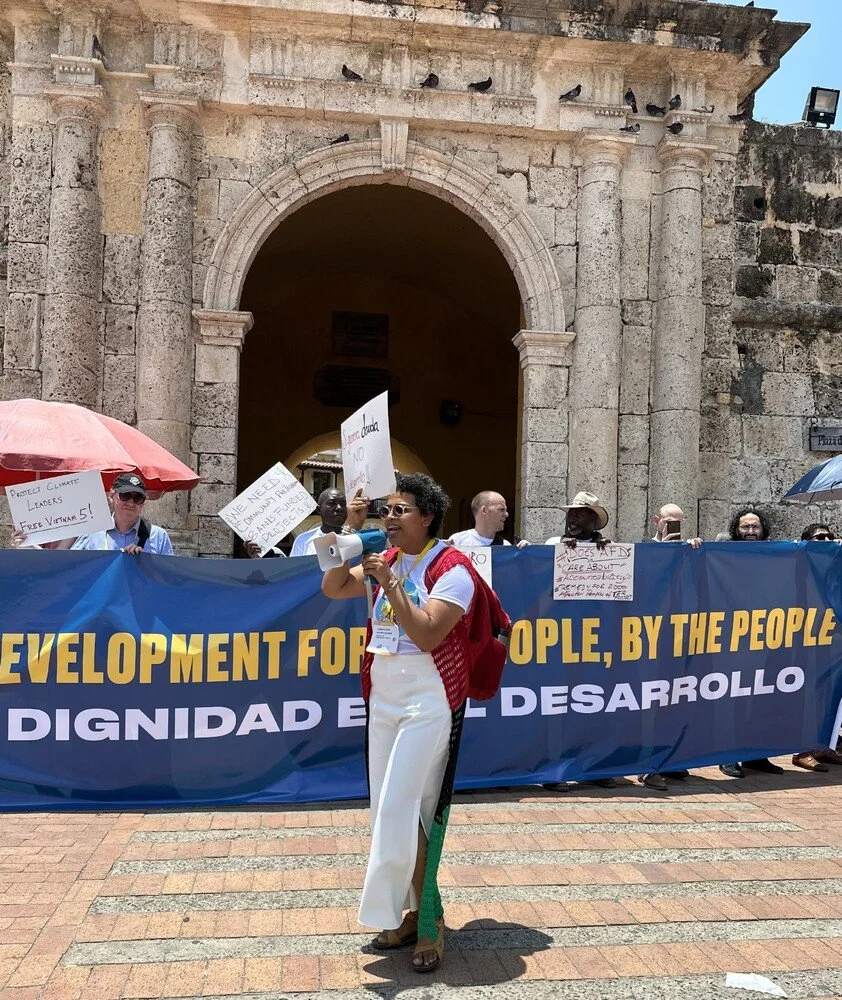Changemaker Spotlight: Coalition for Human Rights in Development
Last year, Word Force joined our Changemaker partner organization, Coalition for Human Rights in Development to support their members in making a narrative intervention at the Finance in Commons Summit in Cartagena, Colombia. While FICS self-proclaimed goal is to “build more inclusive and sustainable global financial architecture, last year was the first time frontline communities and organizations were included. The summit and similar gatherings of powerful people who control much of the world’s wealth has been a place where harmful narratives are born and spread. And though public development banks are, in theory, supposed to be doing better than their private counterparts, that’s not typical. Deals are made behind closed doors, without meaningful community input or decision-making power.
When we touched down in Cartagena to support the 25 members from frontline communities that CHRD supports, we had the foundation of the Narrative Style Guide to steer our work together. The Narrative Style Guide features a narrative positioning statement, helpful and harmful narratives, simplified definitions of language used in your work and audiences and targets in your network and you’d like to reach. With our support, CHRD identified that “development for the people and by the people” as a message that reflects the long-term narrative goal of dignity and self-determination for all its partners and member organizations. Our role in Cartagena was to help folks identify the stories from their work that show what development for the people, by the people, looks like in practice.
We met John Brownell, a physicist turned community organizer and activist for Green Advocates International in Liberia. Brownell and his colleagues worked to organize six communities around the base of Wologizi Mountain range, an area rich in untapped iron ore that developers covet. Their team went from community to community to talk about what they wanted and needed. At the end of many community discussions and meetings, each one erected a public board with a list of developments they’d like to see. These visions for themselves helped the community resist when developers came in wanting to extract resources in exchange for just rice and bread, a common practice. When each community was approached, they showed the developers their development priorities and sent them away when what was proposed wasn’t on their list. Despite their distinct visions for the future, these communities found solidarity in their resolve to safeguard their collective interests, setting a precedent for what community-led development can be.
Both the Narrative Style Guide and our work with partner organizations emphasizes the need to use humanizing and simplified language when communicating about your issue, regardless of the medium. We saw both of those intersect in Cartagena as the language used to write and talk about development is often jargon-heavy and often strips people of their humanity. Goals are often written in a way that you forget there are actual people involved. We connected with Gerald Kankya, founder of Tweraneho Listeners Radio Club, a human rights organization in Uganda. We met with Kankya to strategize for his presentation in one of the final plenary sessions of the Summit. His goal was to highlight the harms of investment made without community input and the need for development to create better living conditions and respect for human rights. Kankya highlighted a common term used when talking about development: stakeholders. Even though ‘stakeholders’ is technically accurate, it makes it easy to forget who is behind the jargon: real people and real communities. We talked about how using plain language and stories is one way to disrupt harmful narratives and make more powerful arguments for community-led development. For Kankya, that meant highlighting young people organizing to protect the environment or Indigenous Ugandans trying to save forest systems from being cut down by World Bank projects rather than ‘stakeholders.’
Our experience in Cartagena underscored the value in a Narrative Style Guide as a foundation to centering the voices and agency of frontline communities in shaping policies and practices that directly impact their lives. It helped us to see the stories that paint the picture of a just future for development. We saw it in use in the messages and themes that CHRD shared with each other and at FICS. And now as we revisit the Narrative Style Guide with CHRD to make sure it continues to reflect the deeply held beliefs, ideas and values that will make their work easier, we’re reminded that this is a living document that is meant to shift and grow as the landscape changes. We hope that this can be a tool for other organizations working toward a just and sustainable future for all.

